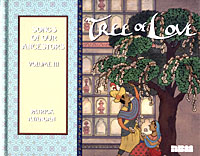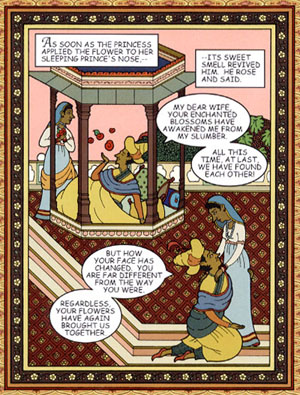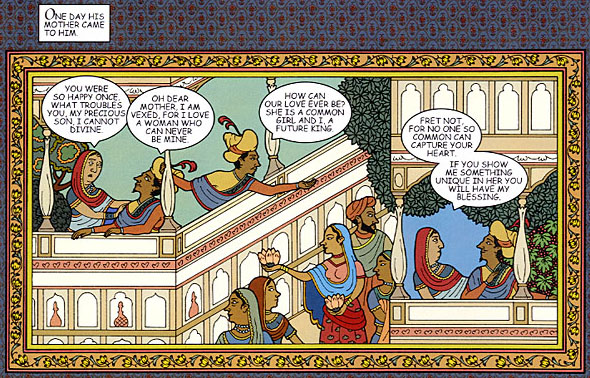 By Patrick Atangan
By Patrick Atangan
48 pages, color
Published by NBM
Patrick Atangan’s comics debut, The Yellow Jar, was a beautiful retelling of ancient Japanese folk tales using the ukiyo-e art style of Japan. With his latest graphic novel, Tree of Love, Atangan’s tackling the Rajput Polyptich art of India and the end result is just as visually stunning.
 A prince has fallen in love with a fair maiden, but cannot figure out how to woo her over to his side. What he does not realize is that even if succeeds, the two will still have many travails ahead that will take them both to the far ends of the world and back.
A prince has fallen in love with a fair maiden, but cannot figure out how to woo her over to his side. What he does not realize is that even if succeeds, the two will still have many travails ahead that will take them both to the far ends of the world and back.
The story itself in Tree of Love is in many ways just average. It’s the age old set-up of boy meets girl, boy loses girl, boy regains girl, to be certain. Even the details of the story itself, though, are rather predictable. The prince’s wooing of the flower girl is slightly uninspiring, with each turn of events expected by the reader. It’s not directly the fault of Atangan, who’s merely adapting an Indian folk tale, but I really do wish he’d picked a slightly more exciting story to adapt. It does move quickly, though, and that’s what kept me from even the possibility of getting bored.
The real shining star of Tree of Love is definitely Atangan’s art. Each page is drawn as one massive image; no panel borders or other typical comic book features are present, just a massive image where the characters move across its boundaries. It’s a very difficult style to pull off and it says a lot about Atangan’s skill that he makes it look so easy. Not only does Atangan make sure that your eye flows across the image in the correct sequence of events with great ease and smoothness, but each drawing also works as a piece of art in its own right. Each page is a scene with people walking across it, or sitting within its borders, and at a glance it looks like a portrait. It’s only when you look close that you realize that it’s also doubling as sequential art, telling part of a story. It’s a real feat that this works so wonderfully, and where the story faltered for me it more than makes up for it by providing me art that I can look at over and over again.

Despite my problems with the too-standard story of Tree of Love, the art alone is more than worth your time and money. It’s a beautiful book, one that will do quite well on the shelf of any lover of art. Each of Atangan’s books has been a visual joy, and Tree of Love is no exception to that rule.
Purchase Links:
